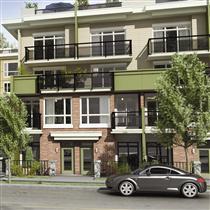Construction on pre-sold projects continues as market slows
Derrick Penner
Sun
Housing starts across Metro Vancouver took a big jump in July as builders continued banging up new homes at a faster clip than in 2007, Canada Mortgage and Housing Corp. reported Monday.
Builders started work on 1,904 new homes in Metro Vancouver in July, a 25-per-cent increase from the same month a year ago. The gain was entirely in multi-family projects, which offset a three-per-cent decline in single-family-home starts.
The rise in housing starts in the face of a slowing resale housing market largely reflects builders starting work on housing projects that were planned, pre-sold and permitted last year, Richard Sam, a CMHC analyst, said in an interview.
“Housing starts lag the housing market to some degree,” Sam said.
“A lot of things that we’re seeing right now in terms of housing starts, the majority are multiple-family and pre-sold late last year or early 2008, when the market was a little bit better in terms of sales.”
Sam expected housing construction to continue at high levels to the end of the year, still fuelled by that stream of pre-sold projects. CMHC is forecasting that housing construction will moderate in 2009.
To the end of July, Metro Vancouver starts of 12,082 outpaced last year’s starts by 11 per cent. The biggest jumps were in Vancouver and Surrey.
Peter Simpson, CEO of the Greater Vancouver Home Builders’ Association, said housing starts are going up at a pace to equal the region’s best year since 1993.
“If new-home sales start to drop off markedly [through the balance of the year], you would see that in [lower] starts,” Simpson said. “Right now, we don’t see that happening.”
Last week, Statistics Canada reported that the value of building permits issued in Vancouver over the first six months of 2008 declined by 28 per cent compared with the same period a year ago.
However, Sam said it can take a long time for slowing of permit activity to be reflected in housing starts because it takes a number of months after a permit is issued, particularly for larger multi-family projects, for a builder to reach the stage where Canada Mortgage and Housing counts its units as having been started.
Surrey, Vancouver and the Tri-City communities of Port Moody, Coquitlam, Port Coquitlam region showed the biggest increases in starts.
Builders in Vancouver started 3,025 new homes during the first seven months of 2008, up from 1,881 in the same period a year ago, with increases in both single-family construction (431 units this year versus 342 last) and multi-family (2,594 versus 1,539 last year.)
Surrey saw higher numbers of starts at 3,545 units, but witnessed a drop in single-family starts (810 houses started this year versus 852 last year).
The increase in the Tri-Cities was mostly due to the start of large multi-family projects that totalled 1,062 units during the first seven months, versus 279 units at the same point a year ago.
Housing starts in Abbotsford, however, plummeted 55 per cent in July compared with the same month a year ago, to 38 units. The biggest part of the drop was in multi-family projects where builders started on just six units, compared with 36 in July 2007.
The July dip softened Abbotsford’s results for the year to date, which saw builders start work on 953 units to the end of last month, up 24 per cent from the year previous. Sam expected starts in the Fraser Valley to slow over the last five months of the year.
Langley, with a 43-per-cent drop to 411 units, and Maple Ridge, which dropped 32 per cent to 250 units, experienced the biggest declines in new-home starts.
Sam said that perhaps high gasoline prices are having an impact on buyers’ decision-making.
“The old notion was that if you couldn’t live in Vancouver city, you could live in the outlying areas, Burnaby, Richmond or further out,” Sam said. “But now we have higher gas prices and think this is limiting that.”
Nationwide annualized housing starts plunged 13.6 per cent in July, dropping to 186,500 units from 215,900 units in June, CMHC reported.
Urban starts nationally fell 14.8 per cent in July from June. Multiple housing starts dropped 20.2 per cent to 91,600 units, while single starts cooled 6.6 per cent to 69,800 units.
Vancouversun.com readers had lots to say about housing development in the Lowe Mainland. Here’s a sample of their comments.
“It’s called overbuilding! Inventories are way up, and sales are down in the lower mainland. Most of these are multi-family projects — townhouses and condos — which were planned years in advance with buyers putting little money down, and intending to flip them for a tidy profit afterwards. Too bad people didn’t realize that there are only so many fools willing to pay the outrageous prices. More inventory means softening prices.”
—
“Did builders not get the memo? Lots of inventory, low sales. Yep, THE PERFECT time to start a new project.”
—
“Why all the cynicism? Vancouver housing demand outstrips supply. It’s quite obvious that Vancouver housing is some of the most expensive in the entire country, which presents a perfect investment opportunity for developers. So construction continues. Remember, real estate investing is long-term. Although we may be in a recession now, the overall fundamentals of Vancouver are excellent. It has a booming economy with a rapidly growing population stuck in a constrained space.”
© The Vancouver Sun 2008






